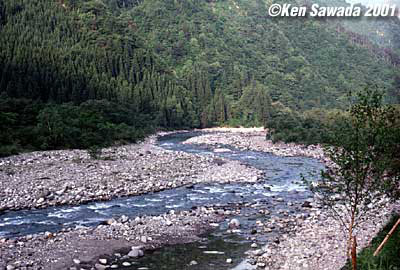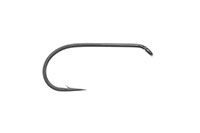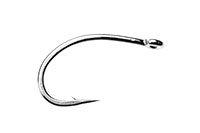
Mountain Streams --Vol.17--
Wild Canary
Wild Canary as well as Spent Badger is one of the most popular flies among my original dry flies. Wild Canary has got every inch a canary colour as all parts are made of ginger or light ginger coloured hackle. The canary is a bird in the cage, whereas my Canary is absolutely wild. So I named it Wild Canary. Some people said that the naming came from Japanese word play "kanari (means rather) wild" but it is not my original idea. Nevertheless, it is true that this fly is a wild hunter and the most reliable at any time at any place. It is also a first-class fly as a pilot fly and as a great killer of large fish.
Wild Canary. All sizes from large 10 to small 16 are very effective.
Summer Yamame Trout in the Takahara River
It was about 1980 that I devised Wild Canary. In those days I devised several other spinners and used the right one at the right place with its own atmosphere. That means I chose Apricot Spinner for the Okutama River and its tributaries, Hotaru for the Chikuma River and its tributaries, Prince Royal for the Noro and nearby rivers and Mase Orange and Black Bat for the Mase River. Wild Canary had its first home ground when I started fishing in the Takahara River in Gifu Prefecture in Japan.The Takahara River is very different from ordinary mountain streams. Because the water falling down from the steep mountains of the North Japan Alps gathers here together all at once, it becomes a terribly unruly river. Several sluice gates, through which water is taken from the river, have changed it into a rather milder stream than it used to be, but once it rains it will still turn in a moment into a muddy stream no one can have access. In particular, it is the worst in the snow melting season. The number of days when we can cast the line is fewer than days when we cannot. Moreover, in spite of such abundant water, it is only in May and June that the river flows too rich to walk across. Except those months the river runs only narrowly through the wide bank like a quarry because a large amount of water is taken through the sluice gates. Ordinary rivers never change their water level so dramatically as this river.

Snow melting water polishes yamame trout. Yamame trout in this season is not only beautiful but also the most powerful in the year.
The Takahara River is the most beautiful in early summer when snow melting water calms down. At the same time, however, it means that we have to fight with fall-like current. As big stones make the current flow complicated, good fly drifting is very difficult. Then anglers need a fly that is both buoyant and noticeable enough to fight with the rapid and tricky current. Wild Canary is an ideal fly for those situations.
I put Wild Canary to the leader when I first fished in the Takahara River. It was in the end of June 1982, if I remember correctly. I walked into the river at the edge of Tochio, where the Takahara River changes its name into the Gamata River. Soon I fished a yamame trout. It was just under 30cm but a good fighter. The second yamame trout came up to my fly at the current not far from the first one's place. At a glance it seemed one size larger than the first one. I waited for my fly to be swallowed into its mouth and set the hook to it lightly. Immediately it dashed much faster than ordinary yamame trout and was stuck into the white foam of the current. The rod bent in a large arc and then the reel reversed a little. But that's all. Wondering what happened, I retrieved the line. Wild Canary, which had been in the fish's mouth a second before, returned to me. The leader was not torn, as I had expected. But I noticed that size 14 hook was slightly deformed. That hook is not particularly thin. Actually it had never missed the fish due to its widened bend.

This yamame trout has thin parr mark like a cherry salmon. It is a characteristic style of the Takahara River.
I put another Wild Canary to my leader and headed upstream. 50m upstream, there is an attractive fishing point that can never escape my notice. Narrowing stream falls into a 10m square pool, making big white foam. At the border of that foam lies a big sitting rock that has some space between the underneath and the river bed, as if I had ordered it. It is an ideal stream for big yamame trout to stay. But the trouble is that two trees fall down in the pool, striding the water. How can I cast the fly? Even after I manage to cast it, what can I do if the fish bites the fly? It seems that I can do nothing but draw up the fish between the fallen trees. But if it is too large to draw up between them, what can I do? If the fish run away, passing below the fallen trees, I will not able to land it. It is absolutely impossible for me. Nevertheless, I could not give up casting the fly because the stream was perfect apart from the fallen trees.

After the snow melting water dies down, the Takahara River becomes calm again in June.
I extended the line between two fallen trees and set the fly on the white foam in the head of the pool. The tip of the fly line was on the fallen tree striding the stream. When the fly passed the border of the foam, a pale blue reflection as in the last time came up from behind the bottom stone and my fly disappeared from the surface. I set the hook to the fish more carefully than usual. No sooner had I felt a heavy tug on the line than the fish moved under the foam of the head of the pool. It had very strong power. It would not move, keeping my rod bent in a large arc. Our fighting came to a standstill for a while and suddenly the fish turned over and headed downstream. Without missing a chance I tried to pull up the fish but ended in pulling it up only to the surface. The silver yamame trout much larger than 30cm turned over and ran into the next current downstream, needless to say, passing under the fallen trees. The reel reversed and the line extended as rubbing the bark of the fallen trees. But that did not last long. All was over when the line bit into the bark.
That was what I had feared but I was still bitterly vexed to miss the fish. Then I found the evening was drawing near. Here's my real chance from now! Pulling myself together, I headed upstream. But as soon as I restarted fishing the water suddenly became muddy. Probably because earth and sand on the banks upstream were pulled down when the river improvements works was over. I was forced to call it a day on my fly fishing.

Brother flies of Wild Canary. Apricot Spinner (left) and Prince Royal (right).
Without giving up fishing at once, I walked a bit upstream towards the foot of the staircase to the road. Then a nice pool appeared in front of me. Muddy water robbed me of clear sight but it looked like the deepest pool around here judging from the bedrock of the opposite bank. I changed my leader and the dry fly into 7ft and a half 2X leader and a wet fly. The wet fly has peacock wings and hen pheasant hackles. It is an original fly of Peacock Queen. When I put the wet fly to the leader, it got noticeably dark and the wave that splashed against the bedrock broke white into pieces like flowers on the water. The water is still muddy and there must be no chance today, so I half gave up when I saw something like a large flower blooming on the opposite bank. I stared at it to find the water surface surely burst just in front of the opposite bank. I extended the line little by little and began to cast the fly towards the opposite bank. At my third casting the line that extended diagonally downstream carried the fly to the edge of the opposite bank and I felt a strong bite with a thud. I felt the pull from the rod, characteristic of yamame trout, which swings its head from right to left after hooking. The fighting was not so fierce due to muddy water. But I pulled it up to find it was a nice proportioned yamame trout over 30cm.

Except for the season when the snow melting water flows in the water, yamame trout body seems nothing but a river fish.
After coming back, I examined my flies carefully for the next fishing tour. At first I prepared size 12 and 10 strong hooks with wide gape and tied many Wild Canaries thickly on those hooks. Size 10 spinner is rather larger than ordinary dry fly. Although it is smaller than real mayfly spinners I had to squeeze its wide wings stretched horizontally into my fly box. Fortunately, this large spinner was very successful. This V-cut spinner kept floating easily on the rapid complicated current in the high water season. In addition this fly was remarkably noticeable. From far away or in darkness it was seen very clearly. An angler who was fishing on the opposite bank said that he could see my fly more clearly than his own. Needless to say, hooking performance was remarkably improved.
-- To be continued --
- NET SHOP INFORMATION

SL6 Black Spey Hooks

DU3 Limerick Spinner Hooks

SL4 Single Bartleet Hooks

XD1 Tube Fly Double Hooks

DD2 Flat Perfect Hooks

DD1 Black Terrestrial Hooks

TD4 Old Limerick Wet Hooks

DU1 Silver May Hooks

MU1 Flat Midge Hooks

LD3 Long Limerick Hooks

TD2 Summer Sproat Hooks

XS1 Tube Single Silver Hooks

TD6 Siver Sedge Hooks

SL5 Black Spey Hooks

DU3 Limerick Spinner Hooks
- TROPHY CLUB
- FLY SHOW
- EXHIBITION
- MASTERS`
- FLY DRESSING CONTEST Archives
- TRAVELLER Archives
- TACKLE IMPRESSIONS Archives
- ANGLERS` PHOTO GALLERY Archives
- ----------------------------------------------
- トロフィークラブ
- フライショー
- エキシビション
- マスターズ
- フライドレッシング・コンテスト・アーカイヴ
- トラヴェラー・アーカイヴ
- タックル・インプレッション・アーカイヴ
- アングラーズ・フォトギャラリー・アーカイヴ
株式会社サワダ 185-0021 東京都国分寺市南町3-13-4
SAWADA'S INC. 3-13-4 Minamicho, Kokubunji, Tokyo 185-0021, Japan
写真・ドキュメントの無断転載を禁じます。
All the images and documents found on this site are owned by Ken Sawada and may not be used without permission.
But, link to this site is FREE.
Copyright © 2000 - 2024 SAWADA'S INC.. All rights reserved.
SAWADA'S INC. 3-13-4 Minamicho, Kokubunji, Tokyo 185-0021, Japan
写真・ドキュメントの無断転載を禁じます。
All the images and documents found on this site are owned by Ken Sawada and may not be used without permission.
But, link to this site is FREE.
Copyright © 2000 - 2024 SAWADA'S INC.. All rights reserved.
